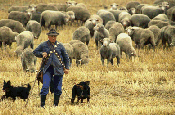Bible | Movies | Books | People | Hot Topics | Holidays | Humor | Gallery | Sanctuary | Sermons | Prayer | Quizzes | Communities | God | FAQ | Links
|
|
The Twenty Third Psalm: Sacred Text As Hypertext The World Wide Web is constructed of hypertext. One text, linked to another, inter-connected throughout the world. Our hypertext version of the 23rd Psalm contains links that will take you through both time and space, connecting you not only to various translations of the Psalm and other related texts, but with music, art, or current events to which these ancient words refer. Thus reading the 23rd Psalm hypertextually, it can become a lens through which you see the world, a lens, we might add, which brings into focus the presence of the Creator within the chaos that swirls around you. Though reading the Bible hypertextually may strike you as something peculiar to the age of computers, in many ways this is how the Bible was meant to be read. David Lochhead, late Professor of Systematic Theology at Vancouver School of Theology, was the first to point this out. He put it this way: "The history of the Bible, I would venture to say, is a history of hypertext. The Bible, as we know, did not simply appear as a unified text. It grew as a collection of texts, read by and affirmed by a succession of communities. There are complex links between the various texts that make up the Bible. By allusion, paraphrase or quotation, one Biblical text references another. Furthermore, the Bible has always been used hypertextually. Rarely is the Bible read in a linear way. If anyone reads the Bible from beginning to end -- as some do -- it will typically be a once in a lifetime event that we will report in just those terms: 'I once read the Bible from beginning to end.' I want to suggest that the typical use of the Bible is hypertextual. We read fragments. We jump from text to text." And,
we might add, reading the Bible hypertextually, we not only jump from one text
to another, we leap from text to context, moving from the words that appear on
your computer screen to that place where the words touch the deep places of your
mind and heart. And if your reading of the text is both careful and creative,
you may find that in the reading you are connected once again with the God in
whom the words were inspired in the first place. By way of illustration, let's use the word "shepherd" as a starting point to begin reading the 23rd Psalm hypertextually. The first step might well be to identify all the other situations throughout the Bible in which the word "shepherd" appears. If this task sounds daunting, not to worry, the process has been automated for you right here on the web. Simply link over to the Bible Gateway , choose your favorite translation, type in the word "shepherd," hit return, and you'll see a list of each and every text in which the word "shepherd," appears. By reading a selection of these passages, you'll begin to appreciate some of the rich associations and connotations that are connected to this one word in the Psalm. Then, too, you can use the Internet to see how others have interpreted this image of the shepherd and the sheep. For example, a series of paintings from the Sistine Chapel in Rome reminds us that Moses was also a shepherd, as were many of the greatest characters of the Bible. Abraham, for example, was a keeper of sheep; David, a shepherd, before he became King. In the book of Samuel, David describes his adventures in the wilderness, how he would do battle with wild wolves and even lions, killing them with his bare hands if necessary to save his sheep. So powerful was this combination of bravery against the wild beasts in the wilderness and tenderness for the sheep that eventually poets and prophets began to see God as the Shepherd of all. This set of images and associations continued into the New Testament where Jesus is portrayed as the "good shepherd." And not only that, it was Christ's own mission to evoke the "shepherd" within us all, challenging every disciple to be a servant of others. This tradition continued beyond the pages of the Bible. Artists, poets, and musicians appealed to this image of the shepherd and the sheep not only in depicting God or Jesus, but in appealing to the shepherd that lies within. Why not take a look at the Sistine Chapel series on the life of Moses, or the Vatican's sculpture of the good shepherd now. Within our own period the image of the Psalm continues to recur in popular religious art, as well as photography, as illustrated below.
And
just so you don't begin to take this hypertext business too seriously, or begin
to think of the word "shepherd" as something that belongs to the world of the
Bible alone, you might try following this link to the shepherd's very own homepage. Familiar Words, Unfamiliar MeaningsThe more familiar translation of this phrase has the shepherd leading us on "paths of righteousness." Quickly now, what associations pop into your mind when you hear that phrase? Maybe nothing very specific at all. Perhaps something about morally correct behavior. Biblical language is more concrete than that. A better translation would be "the right paths," as in the paths that lead to food or safety, or something equally specific. An actual path, road, trail, or highway. The Internet, on which you arrived to encounter these words on your computer monitor, is one such path or trail. But where is it leading you? From these pages you can follow links, forks, branches, thoroughfares and detours to almost any destination that you please. Using one of several "search engin, you can move at will through time and space, often arriving at destinations you never dreamed existed, to encounter sights and sounds you never imagined possible. In this chaos of interconnecting links and paths, who is to distinguish between "right" and "wrong." Can we trust that there is, in fact, a Shepherd who guides us as we surf through such turbulent and chaotic waters? The 23rd Psalm assures us that there is. God is the one who guides us as we search these electronic highways. And more than that. God is doing this for reasons larger than our own entertainment or edification, as important as those reasons are. As the Psalmist affirms, God is guiding us through these digital pathways, for the sake of God's holy "name." This is a radical thought, though the cutting edge of the words has been worn thin by familiarity. Here the Psalmist is suggesting that God's own reputation is a stake in our wanderings. Whether we move aimlessly and without direction, or whether our journey takes us toward the light actually matters to the Creator. And more than that, whether the web itself is seen as a chaotic and meaningless mess of bits and bytes, or, on the other hand, whether a deep order begins to emerge within the chaos, this matters very much to God. In this context the Psalmist is the ultimate optimist, affirming that with the guidance and protection of God, both you, and all such seekers shall arrive at a place of fulfillment, such that finally you shall "dwell in the house of the Lord for ever." More on the Twenty Third Psalm
You are invited to join our Forum (To see the current list of topics your browser must allow Active Content)
Please take a moment to let us know you
were here! For those who prefer a form: Click here to subscribe.
If you want to talk with someone in person, please feel free to call 212-864-5436 Charles also tracks the boundry between the virtual and the real at his blog: Next World Design, focusing on the mediation of art, science and spirituality in the metaverse. For more information about Charles Henderson. |


